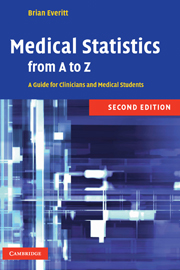T
Published online by Cambridge University Press: 23 December 2009
Summary
Tango's index: An index for summarizing the occurrences of cases of disease in a stable geographical unit where the occurrences are grouped into discrete intervals. Can be used to detect disease clusters occurring over time. See also ratchet scan statistic and scan statistic. [Statistics in Medicine, 1993, 12, 1813–28.]
Target population: The collection of individuals, items, measurements, etc. about which it is required to make inferences. Often, the population that is actually sampled differs from the target population, which may result in misleading conclusions being made. For example, if an investigator is interested in some aspect of characterizing the natural history of rheumatoid arthritis, then the target population will be all patients with the disease. If, however, the investigator examines only those cases arising from, say, the records office of a large university hospital, then it is likely that selective factors will cause the population that is actually sampled to differ from the target population for a number of reasons, including the fact that rheumatoid arthritis does not always require hospitalization. [Colton, T., 1974, Statistics in Medicine, Little, Brown and Company, Boston, MA.]
TD50: Abbreviation for tumorigenic dose 50.
Telephone sampling: The use of a telephone for sample survey data collection. Telephone surveys are commonly used in market research, primarily because good samples can be achieved at reasonable cost. Sampling can be via directories, which can lead to bias because many households are unlisted, or random digit dialling, in which random four digit numbers in known exchanges are generated to assure that both listed and unlisted households are included.
Information
- Type
- Chapter
- Information
- Medical Statistics from A to ZA Guide for Clinicians and Medical Students, pp. 230 - 238Publisher: Cambridge University PressPrint publication year: 2006
